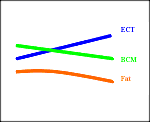|
|
| Basic BIA |
|
|
Interpretation continued:
Optimal weight is an elusive thing to many of us. If you are heavier, it is likely that you will have more in some compartments, but that depends on why you are heavier in the first place.
Say you are a professional football player in a trained state. I would expect you to have more weight mostly because of more muscle tissue.
But, on the other hand, say you have gotten way into this whole alpha-wave relaxation thing and have turned to Leno and Letterman as your major source of entertainment and a full box of candy as your late night delight. I would expect you to have more weight because of fat (a.k.a. “table muscle”). By the way, too much of this is not a good thing… for more reasons than just vanity and fitting into that thong bathing suit!
If you are heavier, but not an athlete or super couch potato, then you are likely to have more of pretty much everything: muscle, ECT, and fat. That is a normal way to gain weight if you eat more than your body uses and you are still walkin’ around.
And what about those of us who tend to be thin?
Well, if you are thinner than other people of the same height there could be a number of reasons. First, you may just have a small frame. Because your expected level of BCM is really related to your height more than your current weight, that could change our expectations. Depending on how small (you can get this checked by comparing your wrist circumference to your height and looking at a frame chart—see the full BIA course for more specifics on this) we might expect you to have up to 10% less BCM. And, for those of you with large frames, we are going to be sticky about it and expect more BCM for your height.
The ECT and fat compartment goals are different. These compartments are more dependent on your current weight than your height. The more you weigh, the more water and fat you might have. So, while the goal for BCM stays pretty much the same for normal and thin weights and only slightly higher for overweight, ECT and fat are goin’ with the flow and movin’ with the weight.
Now you have an idea of a normal situation. Illness and disease is not in the same realm. As it turns out, BIA (using the right set of equations) is an excellent way to monitor your body’s response to stress (because injury, infection, and cancers… even some treatments) and recovery or stabilization. Say you have been sick with a long-term infection, gastroenteritis of some kind, or cancer. These situations lead to very distinct changes in body compartments. A stress response, as far as the body’s composition goes, is pretty much the same whether it is infection, injury, or other sources of inflammation. The severity of the event will determine how wild this looks on BIA. Let’s take a look:
How cool is that?
You know what you can do with this? Here’s a couple of ideas: You can monitor for things that cause this physiologic stress, like infection, wounds, and inflammatory treatments. And, even cooler, you can monitor for the resolution of this physiologic stress!
|
